
A flatfish is a member of the ray-finned demersal fish order Pleuronectiformes, also called the Heterosomata, sometimes classified as a suborder of Perciformes. In many species, both eyes lie on one side of the head, one or the other migrating through or around the head during development. Some species face their left sides upward, some face their right sides upward, and others face either side upward.
Ophidiiformes is an order of ray-finned fish that includes the cusk-eels, pearlfishes, viviparous brotulas, and others. Members of this order have small heads and long slender bodies. They have either smooth scales or no scales, a long dorsal fin and an anal fin that typically runs into the caudal fin. They mostly come from the tropics and subtropics, and live in both freshwater and marine habitats, including abyssal depths. They have adopted a range of feeding methods and lifestyles, including parasitism. The majority are egg-laying, but some are viviparous.
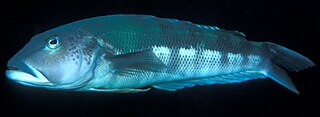
The New Zealand blue cod is a temperate marine fish of the family Pinguipedidae. It is also known variously as Boston blue cod, New Zealand cod, sand perch, or its Māori names rāwaru, pākirikiri and patutuki.

The Suwannee bass is a species of freshwater fish in the sunfish family (Centrarchidae) of order Perciformes. One of the black basses, This species is native to just two river systems in Florida and Georgia, although it has been introduced elsewhere.
The Anguillidae are a family of ray-finned fish that contains the freshwater eels. Eighteen of the 19 extant species and six subspecies in this family are in the genus Anguilla. They are elongated fish with snake-like bodies, their long dorsal, caudal and anal fins forming a continuous fringe. They are catadromous fish, spending their adult lives in fresh water, but migrating to the ocean to spawn. Eels are an important food fish and some species are now farm-raised, but not bred in captivity. Many populations in the wild are now threatened, and Seafood Watch recommend consumers avoid eating anguillid eels.

The silver sweep, also known as the false pompano, sweep, trumps or windawindawi, is a species of marine ray-finned fish from the subfamily Scorpidinae of the sea chub family Kyphosidae. It is native to the southwestern Pacific Ocean from Australia to New Zealand.

Hyporhamphus ihi, the garfish or piper, is a halfbeak found all around New Zealand in shallow inshore waters.

The starry flounder, also known as the grindstone, emery wheel and long-nosed flounder, is a common flatfish found around the margins of the North Pacific.

The yellowbelly flounder is a flatfish of the genus Rhombosolea, found around New Zealand. A different species from the genus Rhombosolea is found in Australia and also goes by the name yellow-belly flounder. The Māori people have commonly fished for R.leporina, and many other species of flatfish, throughout New Zealand's coastal waters for hundreds of years. The Māori name for this species is 'patiki totara'.
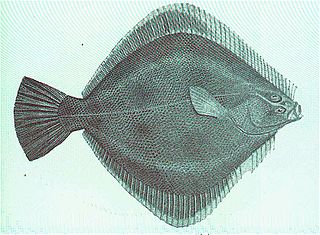
The New Zealand sand flounder is a righteye flounder of the genus Rhombosolea, found around New Zealand in shallow waters down to depths of 100 m.
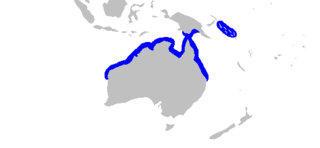
The nervous shark is a species of requiem shark, and part of the family Carcharhinidae, so named because of its timid behavior in regard to humans. It is common in shallow, coastal waters off northern Australia, Papua New Guinea, and the Solomon Islands. A small brownish or grayish shark typically measuring 1.0–1.3 m (3.3–4.3 ft) long, this species has a short, blunt snout, oval eyes, and a relatively large second dorsal fin. The leading margins of most fins are finely edged with black, and the lower caudal fin lobe is black-tipped.
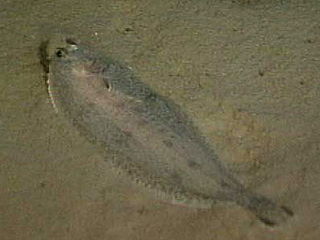
Glyptocephalus cynoglossus, known in English by a variety of common names including the witch, witch flounder, pole flounder, craig fluke, Torbay sole and grey sole, is a species of flatfish from the family Pleuronectidae. It occurs on both sides of the North Atlantic Ocean on muddy sea beds in quite deep water. In northern Europe it has some importance in fisheries as a food fish.

The European flounder is a flatfish of European coastal waters from the White Sea in the north to the Mediterranean and the Black Sea in the south. It has been introduced into the United States and Canada accidentally through transport in ballast water. It is caught and used for human consumption.

The solenette or yellow sole, Buglossidium luteum, is a species of flatfish in the family Soleidae, and the only member of its genus. It is characterized by its small size, low-slung semi-circular mouth, and regularly placed dark fin rays. A common and widespread species, it is native to sandy bottoms in the northeastern Atlantic Ocean and the Mediterranean Sea. It is of little commercial value.

Colistium is a genus of righteye flounders native to the southwest Pacific Ocean, where they occur around New Zealand. Both the species reach a length of about 90 cm (3 ft).

The New Zealand brill, Colistium guntheri, is an edible flatfish of the family Pleuronectidae. It is a demersal fish native to shallow seas around New Zealand, at depths of between 27 metres (89 ft) and 49 metres (161 ft). It can grow to 91 centimetres (36 in) in length and can weigh up to 1.8 kilograms (4.0 lb).

Coastal fish, also called inshore fish or neritic fish, inhabit the sea between the shoreline and the edge of the continental shelf. Since the continental shelf is usually less than 200 metres deep, it follows that pelagic coastal fish are generally epipelagic fish, inhabiting the sunlit epipelagic zone. Coastal fish can be contrasted with oceanic fish or offshore fish, which inhabit the deep seas beyond the continental shelves.

The rex sole is a flatfish of the family Pleuronectidae. Locally, it may also be known as a witch or threadfin sole. It is a demersal fish that lives in temperate waters on sand or mud bottoms at depths of up to 900 metres (3,000 ft), though it is most commonly found between 61 and 500 metres. Its native habitat is the northern Pacific, from Baja California in Mexico up the coasts of the United States, British Columbia and Alaska, across the Bering Sea to the coast of Russia and the Sea of Japan. It is slow-growing, reaching up to 60 centimetres (24 in) in length, and it can weigh up to 2.0 kilograms (4.4 lb). Maximum reported lifespan is 24 years.
Noturus flavus, the stonecat, is a North American freshwater catfish of the family Ictaluridae. The common name is due to its habit of hiding near or under stones in fast-moving water.
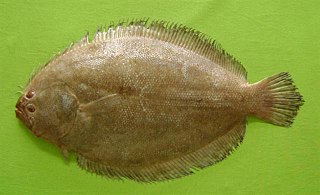
Pseudorhombus arsius, the largetooth flounder, is a species of left-eyed flatfish, that is the dark side with the eyes on the adult fish is the left side of the fish's body, from the family Paralichthyidae. As Rhombus polyspilos it was named as the type species of the genus Pseudorhombus. It is an Indo-Pacific species and is fished for by both recreational and commercial fisheries.
















